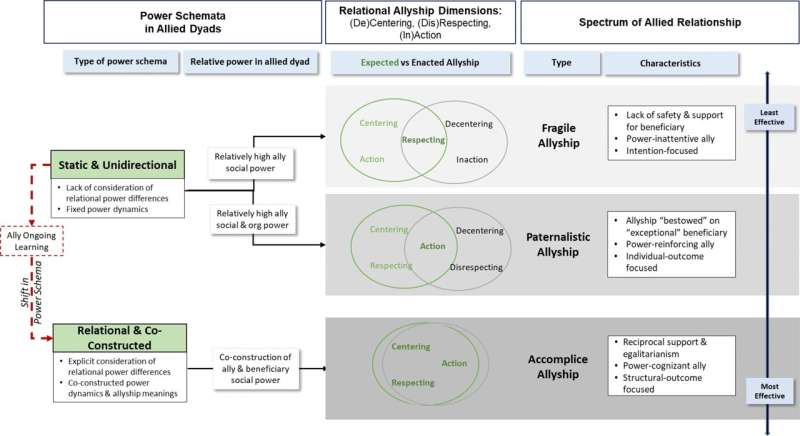This article has been reviewed according to Science X's editorial process and policies. Editors have highlighted the following attributes while ensuring the content's credibility:
fact-checked
peer-reviewed publication
trusted source
proofread
Q&A: Research explores role of allies in shaping inclusive workplaces

In Canada, the concept of allyship has emerged as a pivotal strategy for firms striving to meet their equity, diversity and inclusion (EDI) goals.
In a new study published in Organizational Behavior and Human Decision Processes, "Not all allies are created equal: An intersectional examination of relational allyship for women of color at work," Barnini Bhattacharyya, a professor at Ivey Business School, investigated the power dynamics of allyship as it relates to women of color in the workplace.
Bhattacharyya and her collaborators interviewed 30 Black and Asian women executives and their allies in Vancouver.
She spoke with Ivey Communications to share key insights from the research, and strategies for companies to avoid performative allyship by creating inclusive and empowering spaces.
What steps can organizations employ to foster better allied relationships?
We encourage organizations to customize their allyship training programs to focus on identifying ineffective allyship and how to become more effective allies. This may involve training in emotional regulation and psychological safety, so allies are better equipped to regulate their own fears and emotions.
Because we find ongoing learning to be the key to moving toward effective allyship, we also encourage allyship training to be consistent, ongoing and oriented toward self-reflection and perspective-taking. Allies must undertake ongoing learning to better understand their role in creating inclusive workplaces and strategically using their power.
Dominant allies, particularly those who hold significant organizational and social power, must not only publicly advocate for marginalized groups, but also challenge hierarchical differences in their relationships and realize how maintaining (or even ignoring) these hierarchies further marginalizes their beneficiaries.
This approach, versus one-off training, will help bring tangible change. Our findings also offer food for thought for mentors, sponsors, coaches and managers on how to better support employees.
We also find that over one-third of the allies in our data (as selected by women of color beneficiaries) are other women of color, fundamentally challenging current notions of who is considered an ally. Women of color thus play a crucial role in changing unequal power systems as allies themselves, contrary to prior assumptions which paint them as mere recipients of allyship.
What are the three dimensions of allyship?
Allyship requires a delicate balance between making space for the other person and speaking up when necessary. We identified three dimensions of allyship that help with this. All must occur in conjunction for truly effective allyship:
- Centering: Prioritizing and centering beneficiary's perspectives and needs, instead of one's own.
- Respecting: Treating the beneficiary as a whole person, who is equal to the ally, instead of a powerless individual who needs help.
- Action: Focusing on tangible action that can create tangible, positive impact for the beneficiary, such as calling out mistreatment as it occurs, instead of mere good intentions.
What can people do to avoid performative allyship?
What's powerful about allyship is the possibility of creating systemic change through individual action. Allyship has previously been defined as supportive behaviors enacted by dominant group members (e.g., white employees) on behalf of marginalized groups or group members (e.g. Black employees). In contrast, our research finds that effective allyship is ongoing, power-cognizant, action-oriented, beneficiary-centered and built on solidarity to dismantle unequal power systems.
To avoid performative allyship, individuals must work toward developing a power-cognizant view of allyship. This entails "ongoing learning," which we define as openness and commitment to gaining understanding of unequal power systems through reflecting on one's privilege or marginalization within those systems. This also requires learning to understand beneficiary perspectives, getting comfortable receiving feedback from them and openness to making mistakes as well as learning from those mistakes.
Your study is based in Canada, but do you believe these findings are universally applicable?
We strongly believe these findings can apply universally, because societies and workplaces across the world have social hierarchies and intrinsic power differences, which harm certain groups of people and privilege others. Individuals with relatively high power have the potential to engage in allyship to create positive change for those who are harmed by these systems. They can also engage in allyship to make these systems more equitable.
How did your own diverse racialized experiences impact this study?
My own experiences as an Indian woman and immigrant-settler in Canada, alongside the varied identities of my co-authors, strongly influenced this study. Due to my unique lived experience as a racialized and immigrant woman studying and working in Canada, as well as being an EDI scholar, I hold a distinctive and unique standpoint on allyship.
By being allies to other women of color, as well as receiving allyship, I was able to leverage my lived experience and expert knowledge to develop this research. It allowed me to reflect on my own experiences with and interpretations of allyship at work, which sharpened our analysis.
More information: Barnini Bhattacharyya et al, Not all allies are created equal: An intersectional examination of relational allyship for women of color at work, Organizational Behavior and Human Decision Processes (2024). DOI: 10.1016/j.obhdp.2024.104331
Journal information: Organizational Behavior and Human Decision Processes
Provided by University of Western Ontario




















